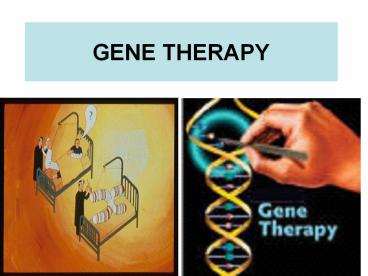GENE THERAPY - PowerPoint PPT Presentation
Title:
GENE THERAPY
Description:
GENE THERAPY General concerns Gene therapy could be very different for different diseases Gene therapy in vivo and ex vivo schemes Transgenes How episomes and ... – PowerPoint PPT presentation
Number of Views:670
Avg rating:3.0/5.0
Title: GENE THERAPY
1
GENE THERAPY
2
In humans
Cancer 69
3
General concerns
Four major problems with gene therapy
4
Gene therapy could be very different for
different diseases
- Gene transplantation
- (to patient with gene deletion)
- Gene correction
- (To revert specific mutation in the gene of
interest) - Gene augmentation
- (to enhance expression of gene of interest)
- Targeted killing of specific cells by introducing
killer gene - Gene ablation targeted inhibition of gene
expression
5
Gene therapy
In vivo
Ex vivo
6
in vivo and ex vivo schemes
http//laxmi.nuc.ucla.edu8237/M288/SChow_4_10/sld
005.htm
7
Transgenes
Integrated
Not integrated
- stable expression may provide a cure
for episomes (plasmids) random mutagenesis not
an issue
- random insertions in heterochomatin can be
inactivated In euchromatin -- Can disrupt
important host genes Long-term consequences are
unknown
- expression is transient repeated treatments
necessary
8
How episomes and integrated trasgenes behave in
dividing cells
Integral transgene
Episome
Loss of plasmid
9
Influences on choice of vector
high efficiency viral vectors
for gene replacement
therapy of monogenic diseases (cystic fibrosis
SCID hemophilia)
10
Desirable characteristics of gene delivery vector
1. High titer or concentrations (gt108
particles/ml)
2. Easy and reproducible method of production
3. Precise and stable introduction of transgene
4. Vector should not elicit immune response in
the host
11
Methods of gene delivery (therapeutic
constructs)
-- Injection of naked DNA into tumor by simple
needle and syringe
-- DNA coated on the surface of gold pellets
which are air-propelled into the epidermis
(gene-gun), mainly non applicable to cancer
-- DNA transfer by liposomes (delivered by the
intravascular, intratracheal, intraperitoneal or
intracolonic routes)
-- Biological vehicles (vectors) such as viruses
and bacteria. Viruses are genetically engineered
so as not to replicate once inside the host.
They are currently the most efficient means of
gene transfer.
12
MOST COMMON VIRAL VECTORS
Retroviruses
Adenoviruses
Adeno-associated viruses
Herpes simplex viruses
13
Retroviral vectors are able to infect dividing
cells only
Preintegration complex of retroviruses non able
to penetrate nuclear membrane.
In dividing cells nuclear membranes are broken
down, so viral genome can enter and integrate
into the chromosome
Infection of dividing cells only
Good for cancer gene therapy
Nevertheless, retroviruses are most often used
vectors for common disease gene therapy
Every therapeutic construct should include safety
features
14
Drawbacks of using a pseudotyped retroviral
vectors
- Host range now is too broad.
- Cell-specific targeting not possible,
- but we can use it for ex vivo approaches.
2. G protein of VSV is very immunogenic (so,
its one-time approach)
3. G protein of VSV is toxic for cell
pseudotypes could be produced only by already
dying packaging cells (overcome by inducible
promotors)
Other pseudotypes are available
HFV human foamy virus, HIV-1, LCMV
(lymphocytic chiriomeningitis) non toxic for
cells
15
Lentiviral vectors
Lentiviruses are retroviruses that can infect
both dividing and nondividing cells
Preintegration complex of lentiviruses can get
through the intact membrane of the nucleus of
the target cell.
Able to infect nondividing or terminally
differentiated cells such as neurons,
macrophages, hematopoietic stem cells, retinal
photoreceptors, and muscle and liver cells
Example of lentiviruses HIV-1 (infects T-helper
cells) AIDS.
Good feature no immune response!
16
ADENOVIRUSES
non-enveloped viruses containing a linear double
stranded DNA genome
40 serotypes known most producing respiratory
infections in humans
subgroup C serotypes 2 or 5 are predominantly
used as vectors
can infect both dividing and nondividing cells
12 antenna-like fiber projections for virus
attachment
www.nobel.se
17
Problems with adenoviral vectors
1. Cannot integrate with the host cell genome
expression from adenoviral vectors is transient
(5-10 days) due to immunoclearance of the virus
Days posttreatment
in vivo hepatic gene delivery to hemophilia B
dogs.
18
Adeno-associated virus (AAV)
Can be ideal as
-- does not stimulate inflammation in the host
-- does not elicit antibodies against itself
-- can enter non-dividing cells -- integrates
successfully into one spot in the genome of its
host (on chromosome 19 in humans).
How to make expression tissue specific?































